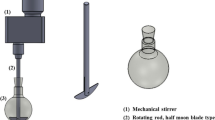Abstract
Bacillus subtilis α-amylase, which contains a relatively large amount of α-helix, was adsorbed on two types of ultrafine silica particles (silica-1 and-2, average diameter 15 nm) under various conditions. The changes in circular dichroism (CD) spectra of α-amylase upon adsorption were measured, and the extent of conformational changes was estimated from the reduction in α-helix content. In additions the activities of adsorbed α-amylase were measured at pH 5.2 using corn starch andp-nitrophenylbenzyl α-maltopentaoside (BG5P). In the ultrafine silica-2 particles, the extent of both activity reductions and conformational changes upon adsorption was much larger than that in the ultrafine silica-1 particles and increased with decreasing pH and amount of adsorption. The extent of activity reductions correlated closely with the conformational changes. On the other hand, the effect of reduction in α-amylase activity upon adsorption measured by BG5P was smaller than that measured by starch, indicating that the lack of accessibility of the active site to a large substrate also reduces the activity of adsorbed α-amylase. However, the effects of particle type and adsorption conditions on the extent of activity reductions by the accessibility resistance were small. Therefore, variation of the activity of adsorbed α-amylase is mainly attributable to the extent of conformational changes upon adsorption. Based on these results, a procedure to prepare adsorbed α-amylase with high activity was investigated.
Similar content being viewed by others
References
Bernfeld P (1955) Amylases, α and β. Methods Enzymol 1: 149–158
Chen Y-H, Yang JT, Chau KH (1974) Determination of the helix and β-form of proteins in aqueous solution by circular dichroism. Biochemistry 13: 3350–3359
Clark DS, Bailey JE (1983) Structure-function relationships in immobilized chymotrypsin catalysis. Biotechnol Bioeng 25: 1027–1047
Clark DS, Bailey JE (1984a) Kinetic and EPR spectroscopy studies of immobilized chymotrypsin deactivation. Ann NY Acad Sci 434: 31–38
Clark DS, Bailey JE (1984b) Characterization of heterogeneous immobilized enzyme subpopulations using EPR spectroscopy. Biotechnol Bioeng 26: 231–238
Gabel D, Steinberg IZ, Katchalski E (1971) Changes in conformation of immobilized trypsin and chymotrypsin, followed by fluorescence. Biochemistry 25: 4661–4669
Horbett TA, Brash JL (1987) Proteins at interfaces; Current issues and future prospects. In: Horbett TA, Brash JL (eds) Proteins at interfaces. Physicochemical and biochemical studies. American Chemical Society, Washington, DC, pp 1–33
Junge JM, Stein EA, Neurath H, Fischer EH (1959) Amino acid composition of α-amylase fromBacillus subtilis. J Biol Chem 234: 556–561
Kondo A, Oku S, Higashitani K (1991) Structural changes in protein molecules adsorbed on ultrafine silica particles. J Colloid Interface Sci 143: 214–221
Kondo A, Murakami F, Higashitani K (1992) Circular dichroism studies on conformational changes in protein molecules upon adsorption on ultrafine polystyrene particles. Biotechnol Bioeng 40: 889–894
Kondo A, Murakami F, Kawagoe M, Higashitani K (1993) Kinetic and circular dichroism studies of enzymes adsorbed on ultrafine silica particles. Appl Microbiol Biotechnol 39: 726–731
Kondo A, Urabe T, Higashitani K (1994) Bioconversions in an aqueous two-phase system using enzymes immobilized on ultrafine silica particles. J Ferment Bioeng 77: 700–703
McCleary BV, Sheehan H (1987) Measurement of Cereal α-amylase: a new assay procedure. J Cereal Sci 6: 237–251
Mitchell ED, Riquetti P, Loring RH, Carraway KL (1973) Quaternary structure ofBacillus subtilis α-amylase anomalous behavior in sodium dodecyl sulfate. Biochim Biophys Acta 295: 314–322
Norde W (1986) Adsorption of proteins from solution at the solid-liquid interface. Adv Coll Interface Sci 25: 267–340
Norde W, Favier JP (1992) Structure of adsorbed and desorbed proteins. Colloids Surf 64: 87–93
Steadman BL, Thompson KC, Middaugh CR, Matsuno K, Vrona S, Lawson EQ, Lewis RV (1992) The effects of surface adsorption on the thermal stability of proteins. Biotechnol Bioeng 40: 8–15
Author information
Authors and Affiliations
Rights and permissions
About this article
Cite this article
Kondo, A., Urabe, T. Relationship between molecular states (conformation and orientation) and activities of α-amylase adsorbed on ultrafine silica particles. Appl Microbiol Biotechnol 43, 801–807 (1995). https://doi.org/10.1007/BF02431911
Received:
Revised:
Accepted:
Issue Date:
DOI: https://doi.org/10.1007/BF02431911




